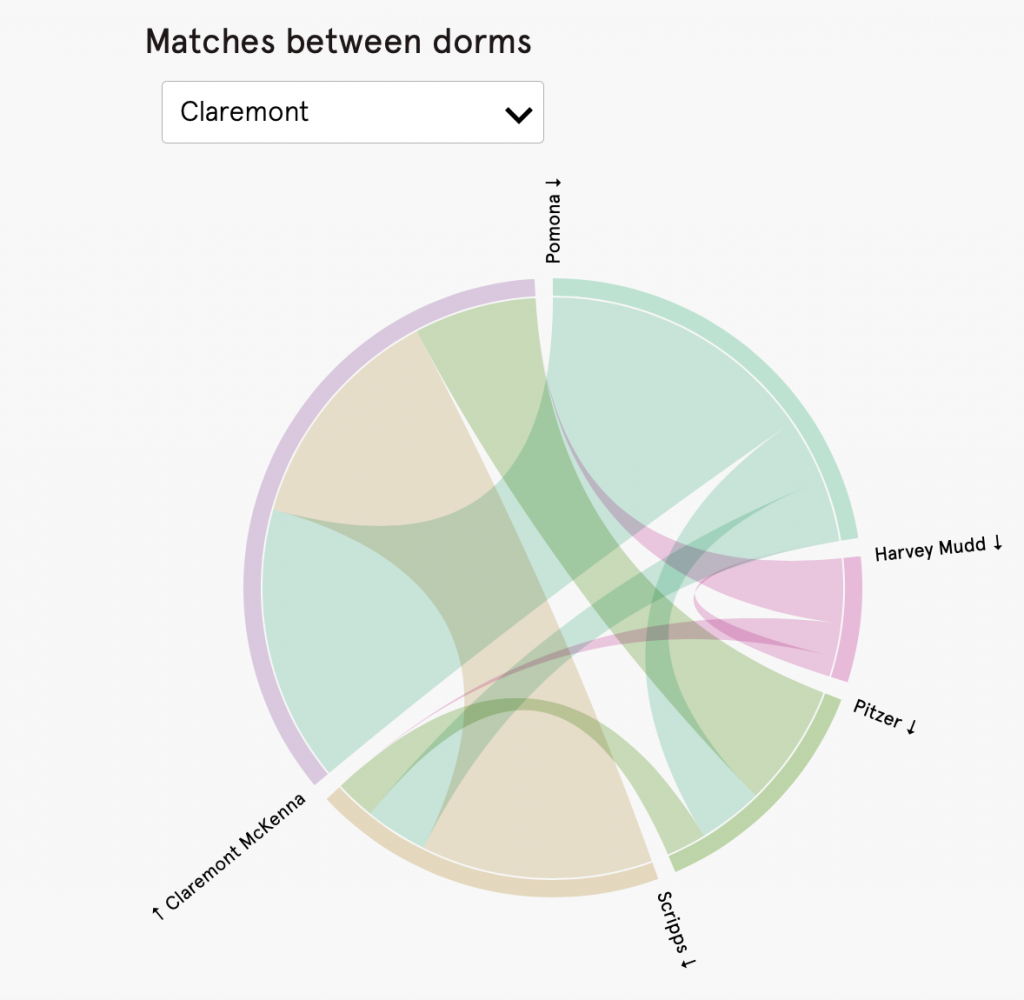Julia Cox ’23
Webmaster
And in 1994, God said, “Let there be Datamatch.” Datamatch, a survey-based program that pairs students with their peers at universities across the country, was founded in 1994 by students at Harvard and has since been implemented at over 30 schools, arriving at the Claremont Colleges (5Cs) in 2019. Since its arrival, Datamatch has been very successful, with over 2,000 survey responses in 2020 and just over 1,200 in 2021, or about a fifth of the total 5C student population.
Participating in Datamatch is simple: students complete a profile, which includes a space for describing one’s gender identity, social media handles, and to denote whether the respondent prefers meeting in-person or over Zoom. Once the profile is complete, participants can move on to the 20-question survey. The survey has Claremont-specific questions (for example, “This question is sponsored by TSL [The Student Life]! I mean, TLC! What is your Strange Addiction?”) and answers (“Saying ‘maybe this time I’ll have fun at green beach!’ every Thursday”) mixed in with more general, yet equally hilarious, questions.
Written by the 15-member staff of the Golden Antlers in one hour-long session, the 40 questions generated were then edited down to the top 20 by the editors. Julia Foodman ’21, the first Editor-in-Chief of the Golden Antlers to attend Scripps College, hoped the survey “made people feel connected.”
“Though not all the jokes are about Claremont, I do think that it’ll help people feel like they’re closer to there, especially first-years who have just never even stepped foot on campus and don’t [have a feel for the community],” said Foodman.
Every participant of Datamatch received 10 pairings through the algorithm, which came out in the early morning of February 14th. If two people then “Matched” each other through the website, they would be able to message each other. A new feature even gave the opportunity to users to go on a virtual date paid for by Harvard Datamatch if they matched with one of their top two pairings.
However, the system is not perfect. Though the ability to customize one’s profile is essential, not every user is honest or upfront according to some who participated in Datamatch. “Why, in the only photo that you can show, do some people choose to show nothing or a random photo like a sheep. Like, I know you’re not a sheep,” said Sara Hove ’23.
“I guess people who are making the meme profiles are trying to be funny, but it kinda takes the fun out of it because then you match with them, and then it’s just like you’re losing a match with an actual person, and that kinda sucks,” adds an anonymous source.
Additionally, one student reported being paired with a person who described himself as a cisgender man in his bio even though the student requested to only be matched with women and nonbinary people. This means that this person marked himself as a woman or nonbinary person either by accident or in order to be paired with these identities. “Because the queer population [of the 5Cs] is smaller by default, having people who are just being stupid is kinda ruining it,” explains this student. “Like, can you please not intrude into queer dating spaces?”
Regardless, many had good experiences with Datamatch and even made connections with their matches that extended past the website. One user felt a particular connection with one of her matches and is still communicating with him over a week since pairings were released.
“One of my [pairings] said something good about Crocs in his bio, and since I recently got platform Crocs, I felt pretty good about that and Snapchatted him a photo. Ever since then, we have been Snapchat besties,” explains this user.
Another user, who wishes to remain anonymous, has been texting one of their matches daily and has even had a Zoom date with them. “I’m surprised I had a match work out so well this year, and it’s been really fun getting to know other members of the Claremont community, especially during a time when we feel so distanced.”
The data between the five Claremont colleges reveal the compatibility of schools and interesting patterns of participants. Claremont McKenna College had by far the most signups with 44.2% of the overall Claremont participants, while Harvey Mudd College had the least with only 5.52% of participants. With matches meaning a mutual match between students, not a pairing made by the algorithm, Pomona College and Claremont McKenna were the most compatible, having 124 matches between students. Scripps and Claremont McKenna duos came in a close second with 104 matches. However, Harvey Mudd and Pomona students only matched nine times, and there were zero matches between Pitzer College and Harvey Mudd students. The most popular greeting for Claremont students was “Howdy, y’all,” while 37 participants had Taylor Swift as one of their two top Spotify artists.
“I hope that people actually do Zoom with their matches, or if not, it’s still something to just talk to your friends about,” says Foodman. “Everybody’s feeling very alienated from the Claremont community right now, myself included, and it’s a fun way to make people feel connected.”
Image Source: Datamatch



